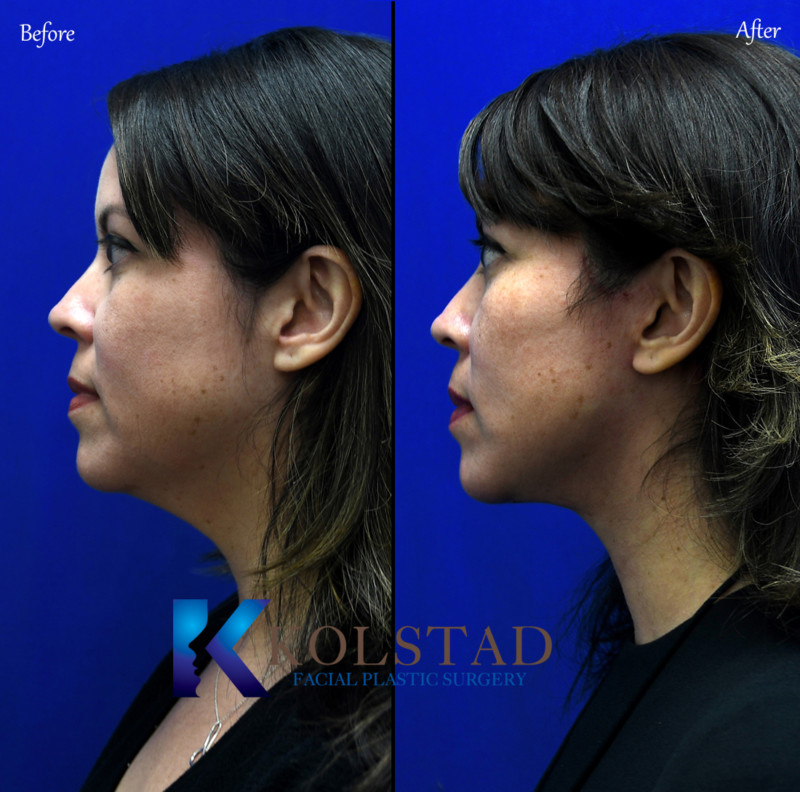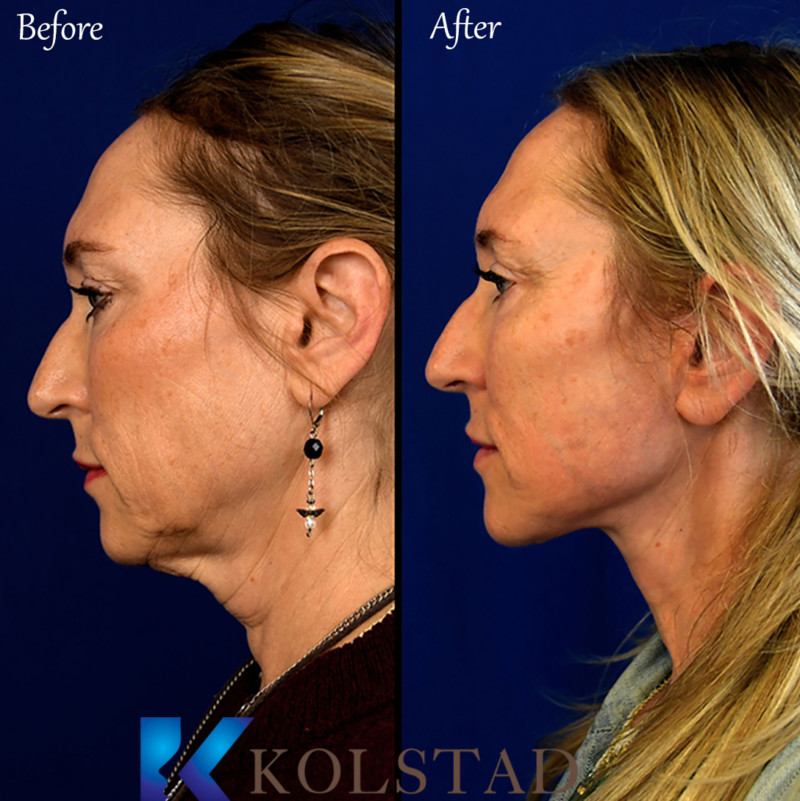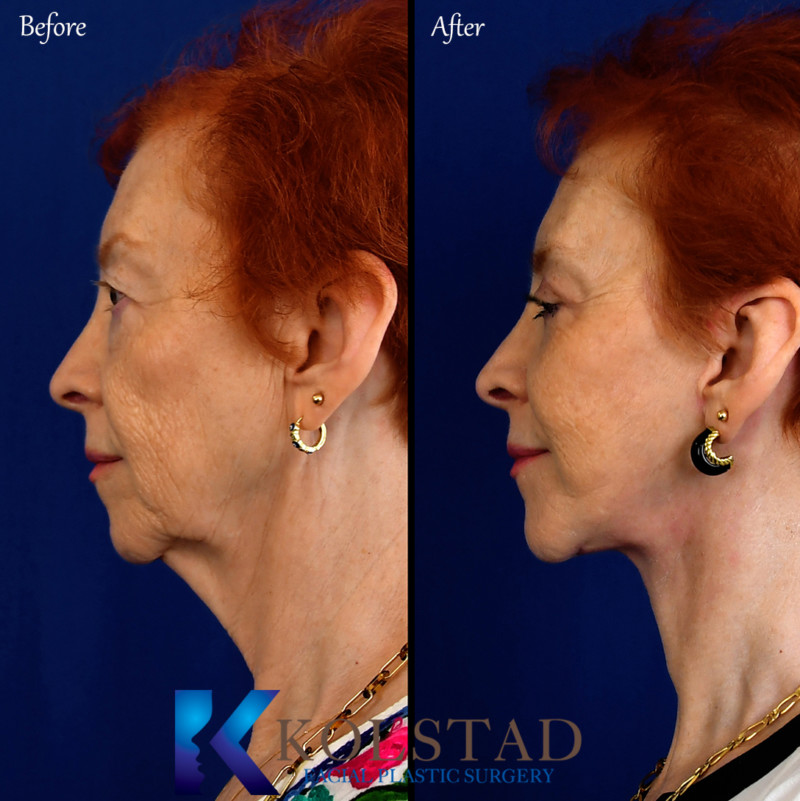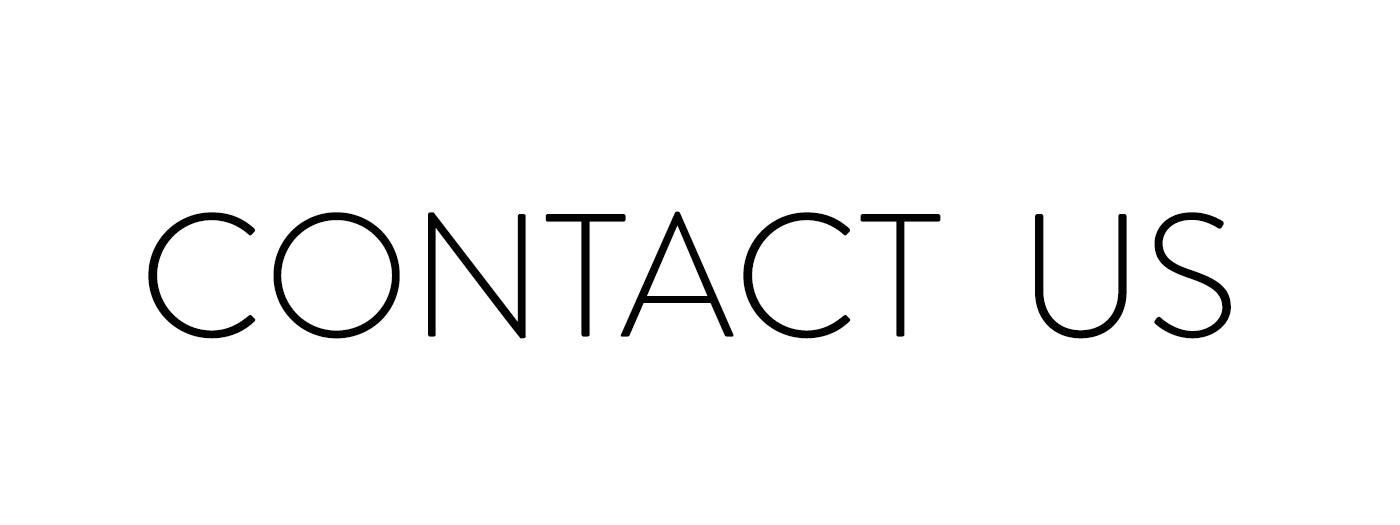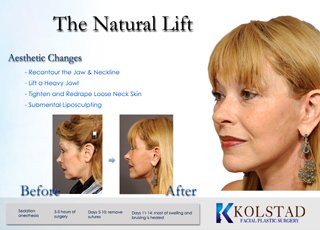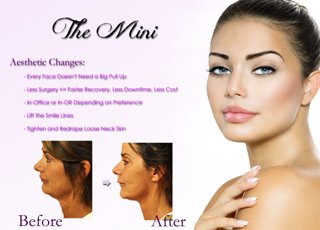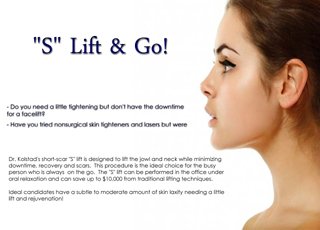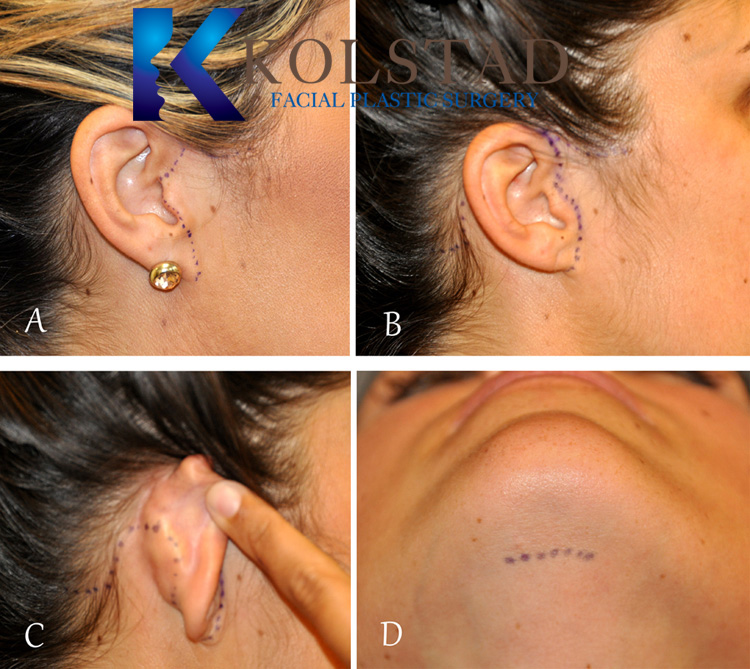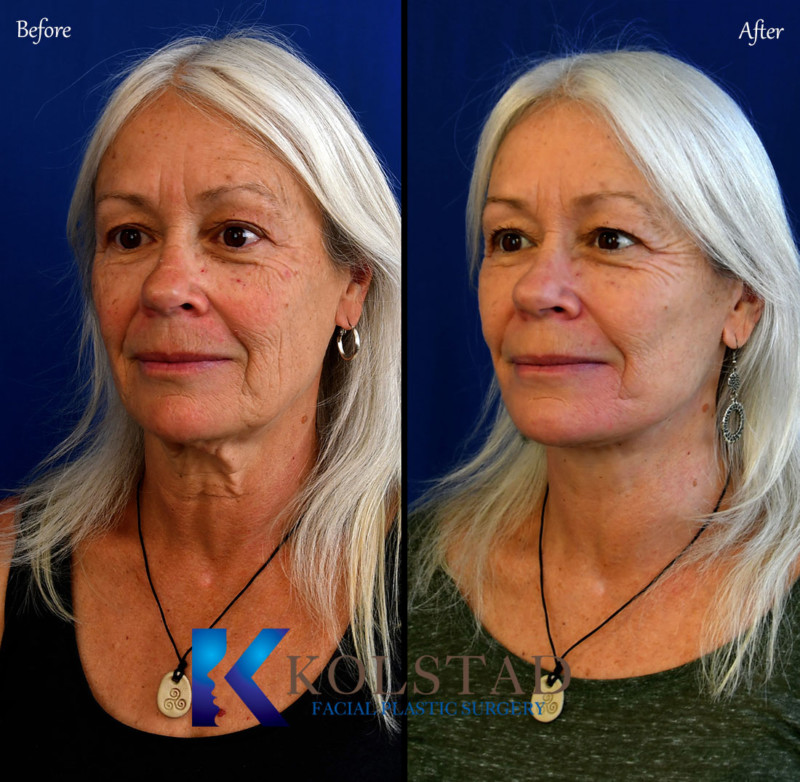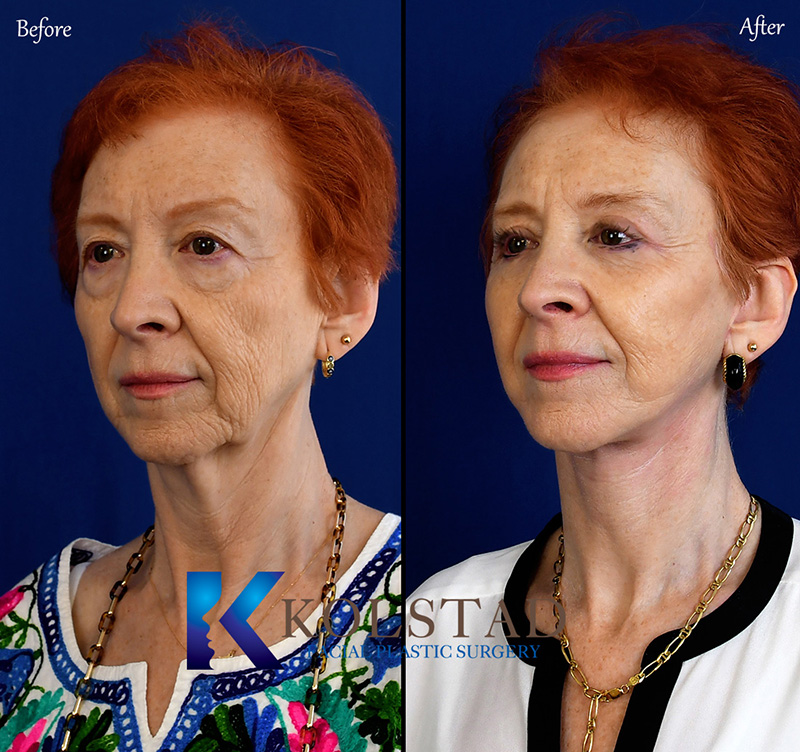Looking for the best facelift in San Diego? The happiest face lift patients are the ones that do their homework before surgery. You can never ask too many questions or do too much research. Check out our large gallery of face lift before and after results to see amazing transformations. If you are interested in neck lift costs or facelift costs in San Diego please give us a call. We can quote ballpark face lift costs over the phone.
Whether you are a better candidate for a mini facelift, a mid-facelift or a lower face and neck lift can seem confusing at first. Within this page, we hope to provide a little clarity about the different types of facelift surgeries Dr. Kolstad offers at his La Jolla Facial Plastic Surgery office.
Facelift surgery is the ultimate solution for facial aging. It redefines and accentuates the youthful contours of the face and neck. A lower lift is the ideal treatment for improving sagging jowls, falling cheeks, and loose neck skin. With so many facelift surgeons in San Diego, it can be hard to find the right one.
Dr. Kolstad is a Board Certified Facial Plastic Surgeon. He does not perform breast or body plastic surgery. By focusing all of his expertise on the rejuvenation of the face and neck, Dr. Kolstad can design a facelift that best fits your unique features.
There are no lasers, ultrasonic devices or chemical peels that can reverse the effects of time and gravity better than a lower face and neck lift. Period. Some facelift surgeons rely on pulling the skin tight in order to achieve a lift. In San Diego facelifts there are many examples of faces that were pulled too tightly. Shortcuts taken during surgery can lead to a stretched, plastic appearance.
Dr. Kolstad’s facelift surgeries take him 3-5 hours to complete. He believes the key to natural results is taking the time necessary to complete the steps without rushing through cases. Choosing the right strategy is very important to achieve natural looking results.
Many faces benefit from facial fat transfer to restore lost volume. Occasionally a platysmaplasty or submentoplasty are required to get the best results. Dr. Kolstad offers a variety of complementary procedures to match your features and create the best facial rejuvenation strategy for you.
Tour Our La Jolla Plastic Surgery Office
Dr. Kolstad learned his technique from one of the best facelift surgeons in the world. He spent an entire year in New York working exclusively with one of the world’s premier Facial Plastic Surgeons. “You do not learn plastic surgery from a book or by watching a video. You learn to become the best by working with the best.” Dr. Kolstad brings this carefully guarded facelift technique to his practice in La Jolla.
At our practice we offer many different surgeries to lift the jowls and tighten loose neck skin. During your consultation Dr. Kolstad will help you decide if you are a better candidate for a liquid face lift, a neck lift, a short incision facelift, a minilift or a SMAS facelift.
There are many methods to redraping tissues that have sagged and succumbed to the forces of gravity. Dr. Kolstad will tailor your surgery to meet your specific needs. Every person ages differently and recognizing the best combination of techniques takes years of training and experience.
During your consultation you will be given the opportunity to address your concerns and dislikes about your appearance. Dr. Kolstad will then walk you through a step-by-step approach on what can be done to improve your neck and jaw line. You will be amazed with his knowledge of available techniques, and you will help him choose which treatment strategy works best for you.
Dr. Kolstad’s practice if fully devoted to plastic surgery of the face and neck. This narrow focus of expertise distinguishes Dr. Kolstad from many of his peers who did not complete advanced fellowships in Facial Plastic Surgery.
Many patients are led into believing that adequate face lifts can be achieved without incisions or with a mere hour and a half of surgery. Dr. Kolstad will not take shortcuts, “Achieving the best, naturally” says it all.
At Kolstad Facial Plastic Surgery our patient safety is paramount. Dr. Kolstad believes the safest place to perform a facelift is in a state-licensed surgery center staffed with board-certified anesthesiologists and nurses.
In San Diego facelift surgery can be performed under intravenous sedation (twilight sleep) or under general anesthesia. The face lift incisions are placed around the ears and occasionally underneath the chin. The operation may reposition the jowls, address platysmal banding or treat loose skin in the neck. Overnight drains are occasionally placed depending on the degree of surgical dissection.
Many times patients will request just a “neck lift”. It is important to know that patients are rarely satisfied with just a neck lift. Why? When excess neck skin is removed, the lax skin of the face bunches up in front of the ears and the look is unnatural.
What Is The Best Facelift For Me?
San Diego Facelift Frequently Asked Questions
WHERE ARE THE INCISIONS FOR A FACELIFT?
A) The preauricular (in front of the ear) incision can be placed behind the ear cartilage (tragus) to conceal the scars visibility. This is the most common incision design for Dr. Kolstad.
B) In some faces the preauricular incision is placed into a natural crease in front of the ear to minimize the visibility. Dr. Kolstad prefers this design for men. Dr. Kolstad will discuss which approach and incision is best for your particular features.
C) The posterior incision extends from the earlobe and gently curves into the hairline for camouflage. Dr. Kolstad places the incision as close to the hairline as possible to minimize visibility and allow for pony tail hair styles after surgery.
D) A small to moderate incision is placed into one of the creases under the chin. Patients that require more extensive submental muscle plication will require a longer incision. After this incision is closed using plastic techniques it fades and is very hard to distinguish from a natural chin crease.
WHAT IS A DEEP PLANE FACELIFT?
A deep plane facelift is a face lift technique that focuses on muscle elevation and suspension. The muscle layers of the face are loosely described as the SMAS (superficial musculoaponeurotic system). Mini facelifts typically rely on tightening loose skin. The “pulled” look many patients are afraid of is generally the result of over tightened skin. Deep plane and subSMAS face lifts focus on muscle elevation and suspension and avoid the “wind tunnel” appearance after surgery.
Dr. Kolstad performs a modified deep plan facelift for many of his patients. Patients with heavy jowls and sagging platysma in the neck require significant muscle dissection. Many patients feel tight after face lift surgery due to the muscles of the face and neck being lifted and suspended to a more vertical orientation.
LOWER FACE AND NECK LIFT
Patients with sagging jowls, loose neck skin or sagging neck muscles are great candidate for face lift surgery. A lower face and neck lift rejuvenates the mid-to-lower face and neck. Full face lifts address brow drop, hooded eyes or fat bags around the eyes. These are some general characteristics that Dr. Kolstad looks for in excellent facelift candidates:
- You have mid-face sagging
- You have deep creases under your eyes
- Your have deep smile lines or nasolabial folds
- Sagging jowls and loss of a jaw definition.
- You have fatty, sagging areas just below your cheekbones
- You have loose skin, wrinkles, vertical cords, and fatty tissue on your neck
IS THERE PAIN AFTER FACE LIFT SAN DIEGO SURGERY?
The majority of our patients do not complain of significant pain after surgery. Dr. Kolstad prefers all of his patients to be off the prescription pain medicine the day after surgery. Most patients describe a feeling of tightness due to the muscle suspension but they do not often complain of pain. Dr. Kolstad recommends using Ibuprofen or Tylenol as needed for the generalized discomfort after neck lift or facelift surgery.
CAN I GO HOME AFTER NECK LIFT SURGERY?
You will have a soft dressing covering your neck and cheeks. You may go home after surgery as long as you have someone to observe you for a 24 hour period. Surgery centers require an individual to pick you up after general anesthesia. Uber, Lyft and car services are not acceptable forms of transportation after general anesthesia. You will also not be allowed to drive home after facelift surgery.
FULL FACE LIFT
The most powerful way to turn back the hands of time is our full face lift. This procedure employs a brow lift, upper and lower blepharoplasty with a lower face and neck lift to harmonize the potential of a lower face lift. Natural results require an orderly progression from top to bottom. Patients with prominent midface and eyelid aging can look pulled if only the lower face is lifted.
Dr. Kolstad can discuss is you a good candidate for a deep plane facelift, lower face and neck lift or our luxury full facelift. Dr. Kolstad approaches every patient’s unique features and creates a customized treatment strategy specific for your face.
WHAT IS THE DOWNTIME FOR FACELIFT SURGERY IN SAN DIEGO?
Dr. Kolstad recommends taking 10-14 days to recover from facelift surgery. There are several visits during the first week to check on the healing and make sure that all of your questions are answered. Many of our patients do not complain of significant pain during the recovery period. Typically many patients require only Tylenol for discomfort after the first couple days after surgery.
Many of our patients have a similar experience during the facelift downtime:
Day after surgery: The surgical pressure dressing is removed. Dr. Kolstad prefers to avoid the usage of drains and their painful removal is avoided in most cases. Dr. Kolstadinspects the face and neck for proper healing. Instructions for proper cleaning and wound care are reviewed and all questions are answered before leaving the office.
Five days after surgery: The external sutures in front of the ear are removed and the incisions are covered using steri strips.
Seven days after surgery: Sutures around the earlobes and the submental incision are removed.
Ten days after surgery: All remaining sutures are typically removed. The face and neck will look swollen but many people feel comfortable enough to return to work. For people wanting to take extra time to make sure the bruising is gone, we recommend taking two weeks to recover. Dr. Kolstad advises initiating scar creams over the facelift incisions.
Seventeen days after surgery: Dr. Kolstad meets with the patient, examines the incisions and clears them for full activity. Dr. Kolstad reviews instructions including range of motion activities and massaging exercises.
Six weeks – 12 months after surgery: Dr. Kolstad uses many injectable medicines to make the scars dissolve throughout the year. Some facelift patients are recommended to return every month for injectable steroids, some are seen less frequently. Dr. Kolstad takes a very hands-on approach during the facelift recovery process in order to achieve the best possible result.
FACIAL FAT TRANSFER WITH FACELIFT
Facial fat transfer uses the patients own body fat to restore hollows and lost volume in the face. Facial aging is the cumulation of multiple processes that cannot be corrected with one procedure. A significant component of facial aging is loss of volume throughout the face. Many patients experience hollowing under the cheek bones and loss of volume in the temples and around the mouth. The best way to correct significant loss of volume is with a facial fat transfer.
Liposuction of the legs or abdomen is used to obtain a small amount of donor fat. The lipocytes are then processed to removed unwanted oils, fluid and blood cells. Dr. Kolstad than transfers the purified fat to areas of the face requiring volume correction. Lifting without volume replacement can lead to a pulled, unnatural appearance.

These are a few possible facelift methods that could be right for your facial aging.
-
- Traditional facelift — This is the “full” facelift for rejuvenating the face, jowls, and neck. A full facelift involves lifting and repositioning the muscles and deeper tissues and removing certain attachments. Dr. Kolstad usually sculpts the fat to avoid creating a hollow look that you see on failed facelifts. Excess skin is trimmed and then re-draped. The incisions with a traditional lift start at the temples, run downward in front of the ear, wrap around the earlobe, and terminate in the hairline of the lower scalp. If the patient has particular issues in the neck area, a second incision is made under the chin to lift, tighten, and trim excess skin on the upper neck.
- Limited-incision/mini facelift — The goals of this facelift aren’t as widespread, instead providing limited rejuvenation around the eyes and mouth, including nasolabial folds and other deep creases. Shorter incisions are made at the temples, around the ears, and if needed, in the lower eyelids and/or under the upper lip. These mini lifts have become the most popular choice.
- Mid-face lift — As the name implies, this lift focuses on the mid-face, lifting the cheeks and removing lines. Mid-face lifts can reduce puffiness under the eyes, correct nasolabial folds, and improve the cheeks. Incisions are small, usually in the lower eyelids or mouth.
- S lift — These lifts focus mainly on the jowls without tightening the neck. Dr. Kolstad calls them S lifts because they involve only short incisions, creating very minimal scarring. The incision is made around the earlobe and behind the ear to the lower scalp. An incision can also be made under the chin.
The process of removing your sutures is a progression. Depending on the method of facelift you had, the location of your sutures can vary. Here’s the timeframe. External sutures placed in front of the ears are removed in 4-5 days. At 7 days, sutures around the earlobes are removed and those behind the ears are loosened. By day 10 after your facelift, all remaining sutures are removed.
Dr. Kolstad uses general anesthesia for more intensive facelift procedures for patients in San Diego and surrounding areas. Short-scar (S) lifts and occasionally mini facelifts can be performed in the La Jolla office using local anesthesia. Of course, if the patient would prefer general anesthesia, that can always be provided instead.
Most people take about 10 days off of work to recover. By the tenth day, all sutures and clips have been removed, the majority of the swelling has resolved and any residual bruising can be camouflaged with make-up.
With a traditional facelift, most patients can return to work in 10-14 days. Endoscopic lifts and mini facelifts may be able to return to work in just a few days. Depending on your unique procedure, Dr. Kolstad will discuss your timeframes with you during your consultation and then afterwards when he sees how your healing is progressing.
After major surgery such as a facelift, most patients want to get their blood moving again and get back to their exercise routine. But you need to be patient — exercising too soon after a facelift can lead to complications and lead to a longer recovery period.
For the first few days of your recovery, you should take short, light walks to encourage blood circulation. But you don’t want to increase your heart rate or blood pressure, as this can cause the tiny blood vessels beneath the skin of the face to bleed.
For the remainder of the first month, activity levels can increase, but heavy lifting, weight training, and any strenuous exercise needs to be avoided. You need to keep your facial blood pressure down.
Four weeks after surgery, you can add light cardio exercise back to your routine, things like slowly pedaling a stationary bike or light aerobics. At six weeks, you can usually return to all exercise, including weight training and strenuous exercise. This can vary by the patient, however.

Liquid facelifts are best for patients with only limited sagging. They last about one year and then another session is necessary to maintain your results.
Specific to facelift procedures, these are the risks:
-
-
- Injury to the nerves that control facial muscles (usually temporary)
- Numbness or tingling around the incision areas (temporary)
- Hair loss at the incision sites
- Skin discoloration (rare but can continue for several months)
- Skin healing issues (more common with smokers)
-
A frequent concern of our patients is looking plastic after facelift surgery. There are limitless examples of unnatural, operated results. When surgeons pull too tight, the corners of the mouth can change, the neck looks stretched and the skin can lose some of their natural contours.
It is very important to choose a plastic surgeon in San Diego that specializes in operating on the face and is comfortable with the challenging anatomy and procedures.
Additional Facelift Procedures
Looking to make the most of your facelift? Additional procedures can be helpful in achieving the most natural looking facelift results.
The most powerful surgery to lift the jowls and tighten loose neck skin is a full lower facelift. Dr. Kolstad’s Natural Lift takes him 4-5.5 hours to complete depending on the complexity of the surgery and the persons anatomy.
This type of procedure is most commonly performed in a plastic surgery center using general anesthesia. Full lower facelifts cost range from $13,000 to upwards of $30,000 depending if combined with complimentary procedures. This price is inclusive of the plastic surgery center facility fees and anesthesia costs for a 4-5.5 hour surgery.
One of our most common procedures is a mini face lift. This procedure can be completed in the office using a combination of local anesthesia and oral sedation. Many of our patients prefer to have this surgery performed in a plastic surgery center using full anesthesia as well.
Mini face lifts cost range from $11,000 to upwards of $20,000 depending if combined with complimentary procedures. The price includes the plastic surgery center facility fees and anesthesia costs for a 3-4 hour surgery.
A neck lift is designed for someone with loose neck skin without a prominent jowl. It is common for someone who had a facelift in the past to need a neck lift without having to redrape the facial skin. This procedure can be completed in the office using a combination of local anesthesia and oral sedation. Many of our patients prefer to have this surgery performed in a plastic surgery center using full anesthesia as well.
Neck lifts cost range from $6,000 to upwards of $12,000 depending if combined with complimentary procedures. . The price includes the plastic surgery center facility fees and anesthesia costs for a 2-3 hour surgery.
A short incision facelift elevates the jowl and improves the jawline. A “S” lift is designed for someone who does not have significant signs of aging and does not require lifting loose neck skin. This procedure can be completed in the office using a combination of local anesthesia and oral sedation. Many of our patients prefer to have this surgery performed in a plastic surgery center using full anesthesia as well.
Short incision facelifts cost range from $5,000 to $10,000.
Revision facelifts require more time to complete and more surgical expertise to perform. Scar tissue from previous surgeries makes dissection more difficult. Improving scars from previous facelift surgeries is a frequent concern of our patients.
Revision facelifts are performed in a plastic surgery center using general anesthesia. Revision lower facelifts cost range from $15,000 or more depending on complexity and scar tissue. The price includes the plastic surgery center facility fees and anesthesia costs for a 4.5-5.5 hour surgery.
Because facelifts are considered to be elective surgery, they are generally not covered by insurance. The only time that would change would be in the case of traumatic facial injury.
Absolutely! Many of our patients choose to enhance their facelifts with the addition of smaller procedures. For results to look perfectly natural sometimes adjunctive treatments are required to create balance.
Submental (Under the Chin) & Neck Liposuction:
Removing unwanted fat can dramatically improve the jaw and neckline. The fat underneath the chin can prove resistant to weight loss and creates a blunting of the neckline. Even after redraping loose neck skin if the submental fat is not adequately treated the results will be limited. No additional incisions or scars are required for neck liposuction.
View examples of Neck Liposuction.
Facial Fat Transfer:
As we age our face loses volume similar to a water balloon becoming deflated. Many surgeons rely on pulling the skin tighter and tighter to address loose skin created by facial volume loss. Simply pulling the skin tighter is a common cause of the unnatural, plastic looking facelift results. The most natural way of restoring your youthful cheek contours is through fat grafting. Facial fat transfer is the process of removing unwanted fat from the belly or hips and transferring it to the deep folds around the nose and mouth, tear troughs, and cheeks.
Find out more about Facial Fat Transfer.
Chin Implant or Prejowl Implant:
As we age we lose bone density. Many people are familiar with osteoporosis of the arms and legs. A similar process occurring in the face leads to loss of chin and facial skeletal volume. An anatomical chin implant can be used to augment lost volume in the jaw. No additional incisions are required for chin implant augmentation.
Read more about Chin Implant Surgery.
Is Recovering From Facelift San Diego Surgery Difficult?
A concern of every facelift patient is what happens when they go back to work. Will people know they had surgery? Will they look plastic after a facelift? Listen to one of Dr. Kolstad’s patients describe her experience about going back to work after surgery. This public speaker was able to confidently return to her everyday routine and was surprised how no one could tell that she had surgery only ten days before.
Returning To Work After Facelift Surgery.
Is There Pain After Facelift Surgery?
* Individual Results May Vary
Dr. Kolstad – Double Board Certified Facial Plastic Surgeon
PREPARING FOR THE PROCEDURE: FACELIFT SAN DIEGO
HOW TO CLEAN INCISIONS AFTER A
FACELIFT
HOW TO REDUCE SWELLING AFTER FACELIFT SURGERY
HOW TO ICE AFTER FACELIFT SAN DIEGO SURGERY
HOW TO REDUCE TIGHTNESS AFTER FACELIFT SURGERY
HOW TO TURN AFTER NECK LIFT SURGERY
Contact Us
To schedule an appointment for a Facelift in La Jolla, San Diego and the surrounding areas call us at (858) 859-2563 or get in touch with the form below.

